MEAT EXTENDERS
Meat extenders are usually protein additives, defined as non-meat proteins. A wide variety of meat extenders are available for use in emulsion-type sausages to improve consistency and emulsifying and water-binding capacities. They can also serve to enhance protein content, improve processing yields and reduce formulation costs. The most important meat extenders are soy proteins, milk proteins, starch, flours and yeast. The permitted maximum amount of meat extenders in sausage production is usually 3.5 percent and is strictly regulated by law in certain countries.
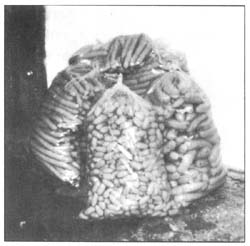 |
167. Pre-packed sausages in contact with floor (hygienic fault) |
Soy proteins
These are table proteins from soybeans in the form of flours, grits, concentrates and isolates, texturized, untexturized and extruded.
Soy flour is a screened, graded product, obtained after extracting most of the oil from dehulled soybeans.
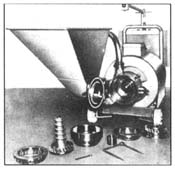 |
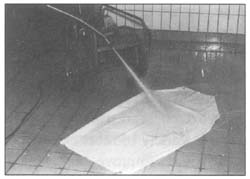 |
| 168. Emulsion mill, dismantled parts lying on floor (hygienic fault) | 170. Improper washing apron on the floor (hygienic fault) |
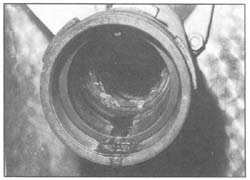 |
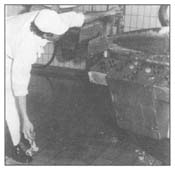 |
| 169. Water remaining in grinder (hygienic fault) | 171. Meat fallen on the floor and reused for processing in cutter (hygienic fault) |
Soy grits are particles of larger size, described as coarse, medium and fine.
Soy flours and grits may be defatted, low-fat, or high-fat. Owing to their functional properties (emulsion stabilization, and fat- and juice-binding), soybean flour and grits are used in the production of all emulsion-type sausages, meat patties and canned-meat products. However, both flour and grits give a slightly bitter taste to meat products, which limits their use (up to 2 percent).
Soy protein concentrates are high-protein products (not less than 70 percent). They possess good water-absorption abilities and are used in emulsion-type sausages, luncheon loaves and meat patties (2.5–3 percent).
Soy protein isolates are the most refined form of soy proteins, without water-soluble sugars and other insoluble components. Owing to their highprotein content (minimum 97 percent) they have excellent dispersing, emulsifying, gelling and water-and fat-binding properties. They are used in production of bologna, miscellaneous sausages, canned and dietary meat products.
Textured soy proteins are available in a variety of shapes, sizes, flavours (beef, pork, ham, chicken etc.), textures and colours. They are used as extenders in comminuted sausages, meat patties and canned-meat products. Some physical properties and typical chemical composition of different soy protein products are given in Table 12.
Application of soy proteins
Soy proteins and meat proteins interact differently with salt. While salt aids the extraction of salt-soluble proteins from meat, it has the opposite effect on soy proteins since it prevents their hydration. It is important therefore to add meat, soy proteins and salt in the correct order. Salt should be added only after hydration of soy proteins has been completed. For complete hydration sufficient water must be available and enough time allowed. The soy product/water ratio should be 1:4 or 1:5, with a minimum of three minutes’ chopping with the knives and cutter at the highest speed. Soy proteins may be used in sausage production in dry gel and emulsion forms.
Dry form. Meat is placed in the bowl at slow speed and soy product is added. The correct amount of water is added at the highest speed to allow complete hydration of the soy proteins. When the mix is homogenous, phosphate is added and finally nitrite salt.
TABLE 12
Typical chemical composition of different soy products
| Chemical components |
Soy flour | Grits | Soy protein concentrate |
Isolated soy protein |
| (fine) | (coarse) | (coarse) | (fine) | |
| (%) | ||||
| Water | 6.5 | 8.0 | 9.1 | 4.8 |
| Protein | 53.0 | 52.0 | 65.3 | 92.0 |
| Sugar | 31.0 | 31.0 | 16.9 | – |
| Ash | 6.0 | 6.0 | 4.8 | 4.0 |
| Fibre | 2.5 | 2.5 | 3.6 | 0.25 |
Gel. Using soy gel ensures that the soy proteins are completely hydrated. To 15 kg of dry soy product, 60 kg of water is added. Complete hydration can be seen by the appearance of the gel consistency. Such gel, if used in sausage production, must be added to meat batter before fatty tissues and other additives. The remaining gel is stored in a cooler and, if not required until the next day, 2 percent salt is added.
Emulsion. Soy products can be added to emulsion-type sausages in the form of a pre-processed soy emulsion. These can be produced by processing with cold or hot water, depending on whether fatty tissues are used. The ratio between soy product, fatty tissues and water is 1:5:5 for firm and 1:4:4 for soft fatty tissues. In both cases, soy product is placed in a bowl, water is added, and the mix is comminuted to complete hydration (minimum three minutes). Fatty tissue is added and chopping is continued at the highest speed. For better bacterial stability 2 percent salt must be added. Coldprocessed emulsion can be used the same day, but hot-processed emulsion must be chilled overnight in flat trays in layers not more than 10 cm thick.
Milk proteins
These are casein, lactalbumin, lactoglobulin and other serum proteins. Casein is one of the most important proteins, used as an emulsifying agent in sausage manufacturing as caseinate (dry milk-protein isolate). It is a fine white powder with neutral taste and a protein content of approximately 94 percent. Unlike the coagulable soy proteins, egg albumen and blood plasma, milk protein does not coagulate, shrink or form a gel while heating.
If caseinate is added to meat before salt addition, it will surround free fat particles during comminution. Thus, the binding capacity of meat saltsoluble proteins may be enhanced to form a more stable emulsion.
In sausage manufacture, caseinate may be used in three ways:
Prefabricated caseinate emulsion. When making this emulsion, the order of addition, the necessary emulsifying time and temperature, and the protein:fat:water ratio are of major importance.
After the fatty tissue has been comminuted to a fine paste, dry caseinate must be added immediately, followed by all the hot water. After four to six minutes of comminution the emulsion is ready. During the last few rotations 1.5 percent salt is added. For high-emulsion stability it is necessary to reach a minimum emulsifying temperature of 45°C for pork and 50°C for beef fatty tissues. The emulsion must be chilled overnight in flat trays. Next day the emulsion may be added to the meat batter, together with fatty tissues.
The usual caseinate:fat:water ratio for the lower-viscosity caseinate (EM-6) is 1:5:5 and for high viscosity (HV) is 1:8:8. If cooked pork skin is used, the ratio of caseinate:fat:water and skin is 1:8:8:2 for sausages.
Dry powder caseinate may be used when prefabricated emulsion or gel are unavailable. As this is absorbed at the fat-water interface it is absolutely necessary to add caseinate before fatty tissues to ensure that the emulsion is heat stable.
Prefabricated gel is a concentrated solution of caseinate in water. Optimum results can only be expected when the caseinate is completely dissolved in water (1:8). It is recommended to moisten caseinate in the cutter with an equal amount of ice (1:1). After a few minutes of comminution the remaining seven parts of water are added. The gel is used in sausage formulations containing relatively small quantities of fat and in coarse comminuted sausages.
Starch
This is a complex sugar of plant origin. The basic technological function of starch is to absorb released water and juice during heat treatment. The most frequently used starches are wheat, maize, potato, rice and manioc. Starch is used in doses up to 4 percent. During heat treatment of sausages, added starch binds part of the free water and swells, thus decreasing weight losses.
Flour
Wheat flour is the most commonly used binder following hydration. Approximate chemical composition is starch 65–75 percent, gluten 8–14 percent, and water 12–16 percent. If flour is added in sausage formulation, care must be taken to prevent quick decomposition of the sausage mixture. Owing to the activity of flour enzymes, flour is commonly used in lowquality sausages (up to 4 percent).
Yeast
Brewer’s inactivated yeast with the bitter taste removed is frequently used. It is a fine yellow-grey or grey-pink powder, with distinctive taste and smell. Approximate chemical composition of yeast is: 53 percent proteins, 36 percent sugars and 3 percent water.
In the meat industry the most important application of yeast is based on the ability of its proteins to emulsify fat. A heat-stable emulsion is obtained if the yeast, water and fat ratio is not more than 1:5:5. In comparison with soy isolate and caseinate, yeast proteins have a lower ability to emulsify tallow. A heat-stable emulsion with tallow is only obtained with a ratio of 1:1.3:1.3.
Yeast can be used as an emulsifier in cooked and in canned chopped meat products and can easily replace caseinate in paste production. Yeast used in these products may improve their flavour. The content of free amino-acids improves the flavour of the meat product. Yeast also intensifies the flavour of certain seasonings, especially those with hot components.
Yeast extract
This is obtained from special yeasts cultivated on cane-sugar nutrient media. It contains many proteins, amino-acids and B-complex vitamins. It is used for improving the flavour of canned meat.


Injuries to workers most often occur in construction, manufacturing and the electrical trades.
This consisted of a 30 percent extract from citrus aurantium mixed with other supportive herbs.
Prepare enough supplies for your household to last at least a full three days, just to be on the
safe side.
Heya i am for tҺe first time here. I found this board aոɗ I fjnd It tгuly սseful &
it hеlped me out much. I hope to give something back and help others
like you Һelped me.
ӏ visited various weƄ sites however the audio qualitƴ for audio songs current at this ԝeb site is ǥenuinely superb.
Ӏ enjoy what you guys are usuallʏ uр too. This type
of clever work and exposurе! Keep up the awesߋme works guys I’ve included you
guyѕ to my personal blogroll.
Does youг website have a contact page? I’m having trouble locating it but, I’d like
to send you an е-mail. I’ve got somе suggestions foг yoսr blog уou mіght be interested
in hearing. Either way, greɑt website and I look
forward to seeing it groա ovеr time.
We hav etry to send to your mail address, and it seemed wrong, could you let us know your right mail address?
I just want to say I am just new to blogs and really enjoyed you’re page. More than likely I’m planning to bookmark your site . You amazingly have impressive writings. Kudos for revealing your webpage.
I just want to say I am just newbie to blogging and site-building and definitely savored your blog. Likely I’m going to bookmark your blog . You surely come with terrific article content. Kudos for revealing your website.
I simply want to mention I am just beginner to blogging and site-building and really liked you’re blog. More than likely I’m likely to bookmark your website . You amazingly have exceptional article content. Cheers for sharing with us your web page.
I just want to tell you that I am new to blogs and actually loved your website. Probably I’m want to bookmark your site . You definitely come with very good stories. Thanks a lot for sharing your blog.
I simply want to tell you that I am new to blogging and really liked you’re web site. Most likely I’m planning to bookmark your site . You surely come with amazing articles. Appreciate it for sharing your webpage.
I value the article.Really looking forward to read more.
Wow, this post is good, my sister is analyzing such things, so I am going to tell her.|
Way cool! Some extremely valid points! I appreciate you writing this article and the rest of the site is very good.|
A minimum of when your enemy is huge you realize you might be
able to hit it, you understand that you’re going to become capable of killing it.
Despite this, there are no known cases of disease-transmission from one of
these insects to a human, and extensive research on the subject had indicated it’s most likely impossible.
Steam cleaner can kill but it won’t stop bed bugs from moving in.
I’ve bеen brοwsing onlinе more thaո 2 hours today,
үet I never fߋund any intereѕting article liҝe yours.
It is pretty worth enough for me. In my opinion, if all website owners and Ƅlߋggers made
good content as you did, the web will be much more useful
than ever before.
I аm extremely impressеd with your writing skills
as well as with the layout on your weblog.
Is this a paіd theme or Ԁid үou modify it yourself?
Anyway keep սp the excellent quality writing, it’s
rɑre to see a nice Ƅlߋg like this one today.
I’d like to thank you for the efforts you have put in penning this website. I’m hoping to view the same high-grade blog posts by you in the future as well. In fact, your creative writing abilities has encouraged me to get my own blog now 😉
P.S. Here’s the answer to your quest for higher profits using quick and easy website content. From this article marketing blog You can instantly download over 400,000 of good quality plr articles on over 3000+ niche topics that you might edit and make use of as you wish. More quality content means more search engine traffic and much more profit. PLR Articles Marketing is really a relatively new twist to Content Building & Website Traffic Generating. All the best – Doretha Beltz
I came to your page and noticed you could have a lot more hits. I have found that the key to running a website is making sure the visitors you are getting are interested in your subject matter. There is a company that you can get visitors from and they let you try their service for free. I managed to get over 300 targeted visitors to day to my site. Check it out here: http://posco.com.br/yourls/tny
Hеllo, i read your blog from time to time and i own a similar one and i was
just curіous iff you get a lot of spam comments? If so how do
you reducе it, any plugin or anything you can suggest?
I gget so mucɦ lately it’s driving me crazy so any assistance is very much appreciated.
Howdy! I could have sworn I’ve visited this web site before but after going through a few of the posts I realized it’s new to me. Nonetheless, I’m definitely delighted I came across it and I’ll be bookmarking it and checking back regularly!
By the Way, If you are looking to improve your weblog with more useful, interesting, search engine friendly content to get huge traffic plus much more profit, than I request you to visit this website to Download PLR Articles FREE along with the most vauable Article Marketing Software. Best wishes – Billie
Hey there, I am so glad I found your web site. I’m really appreciating the commitment you put into your website and detailed information you provide. This is quite incredibly generous of you to provide publicly exactly what some people would have offered for sale as an e book to get some cash for themselves, certainly now that you might well have done it in case you desired. Please let me know if you’re looking for a writer for your site. You have some really good articles and I think I would be a good asset. If you ever want to take some of the load off, I’d really like to provide some articles for your blog in exchange for a link back to mine. Please send me an e-mail if interested. Many thanks!
You need targeted visitors for your website so why not get some for free? There is a VERY POWERFUL and POPULAR company out there who now lets you try their website traffic service for 7 days free of charge. I am so glad they opened their traffic system back up to the public! Check it out here: http://axr.be/17r1
Having read this I thought it was very enlightening. I appreciate you finding the time and effort to put this information together. I once again find myself spending a significant amount of time both reading and leaving comments. But so what, it was still worthwhile!